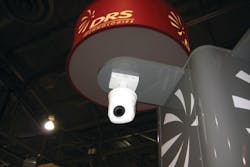For many years, thermal cameras were predominantly used to secure the perimeters of applications that required a level a security above and beyond what is typically required at a facility, such as critical infrastructure sites and military installations. As time as has gone by, however, innovations in thermal imaging have pushed the prices of cameras lower, which has subsequently led to an increase in adoption of the technology.
Many believe thermal cameras are at a point now where they are both viable and cost-effective security measures for a wide variety of mainstream commercial applications.
"Thermal imaging technology now is starting to approach the prices of megapixel cameras," said SightLogix CEO John Romanowich. "So, they’re really being very rapidly adopted and we’re seeing tremendous growth at this time. Thermal is going to be the new megapixel in terms of rapid market growth."
According to Bill Klink, vice president of Flir’s security and surveillance business unit, the prices of thermal cameras are coming down by virtue of increased volume.
"More volume is driving prices down. Adoption is increasing primarily in a horizontal way," he said. "We’re seeing a broader range of people that are deploying thermal cameras. An example might be, a few years ago at higher price points, it was only longer range port security or critical infrastructure-type applications. Now you’re seeing, because thermal cameras are coming down in price, the wider use of that technology down into more common industrial and business park scenarios. Everybody’s got a perimeter… and people in a much broader fashion are deploying thermal cameras in their perimeter applications."
Here are several trends the market is buzzing about at this year’s ASIS show in Philadelphia.
Image Quality
While many people are familiar with the megapixel and high-definition arms race in the traditional surveillance camera market, there has also been a move by thermal camera vendors to produce higher quality images. In the past, thermal images, due mainly to environmental factors, were more prone to becoming washed out or fuzzy, but advancements in the technology are making that more of a rarity these days.
"Part of it is because of several things. One is that the imagers are getting more sensitive, but the image processing is what’s increasing the quality of the image," said Romanowich "Additionally, that same detail is then used to create better results with analytics, which gives you greater coverage of a wider range of operating environments to include daytime operation where cameras really didn’t work that well during the day in the past, as well as more sensitivity to work during rain or snow or any environmental situation."
According to Romanowich, the key to improving thermal image quality lies in the processing of an image itself.
"There are higher resolution (thermal) cameras, but that’s not the issue. The issue has more to do with the fact that the dynamic range of the image is so much that the image processing can correct for it," he said. "For example, you can take an image that’s 320x240 resolution and actually produce a far superior image than a 640x480 if you have the proper image processing to do it. What happens is there is just way too much dynamic information."
Flir is also beefing up its image quality with the release of the new FC-Series camera at this year’s show, which offers wide dynamic range functionality in thermal imaging.
"What separates Flir from other people who make thermal cameras is wide dynamic range performance and it has to do with proprietary technology in some of our image processing," explained Klink. "Specifically, you could be looking at a scene of a perimeter and it’s sunrise, you’ve got the sun just coming up and just like a (traditional) video camera, you’ve got a very bright source, or in this case it’s not necessarily light but heat. Most cameras will clamp down on the sun and you won’t see anything else in the image. With Flir, you’re still going to see a person, a vehicle or animals in the foreground in a very low contrast scene."
Klink added that there has also been a decisive shift in the industry from 320x240 resolution to 640x480. "That doesn’t sound like a lot to video security guys because their doing megapixel, but in the world of thermal imaging, the VGA resolution is the new standard," he said.
IP Migration
As the majority of traditional security camera systems have moved from analog to digital, so to have thermal cameras, according to Todd Brown, senior director of commercial infrared systems for DRS Technologies’ Reconnaissance, Surveillance and Target Acquisition division.
"We’re seeing more and more movement towards IP. The standards conformance, I think is a nice industry trend, which we adopted back when we first developed our first camera," explained Brown. "ONVIF conformance makes it really easy to plug-and-play."
At last year’s ASIS show, Brown said the company introduced its WatchMaster IP Elite fixed thermal camera system, which he said they have had success with and are looking to build upon at ASIS 2012 with addition of new feature sets, as well as a new pan/tilt camera model called the WatchMaster IP Ultra. This new camera model features a 360-degree pan and tilt housing, compliance with ONVIF specifications and low Power-over-Ethernet functionality.
"One of the things that we’ve done is set a new bar of affordability for thermal imaging. Most people in the commercial security market would elect to use an alternative technology to solve their low-light, challenging environment problems and traditionally use an inferior technology because it is lower cost," he said.
Randall Foster, president and CEO of Vumii, which primarily sells its cameras to users in middle-to-high end applications, said that there has been a demand in the thermal marketplace for functionality and feature sets similar to that in the traditional video camera space.
"I would say there is a desire to have thermal cameras with the features and user-friendliness of traditional cameras," he said.
For this reason, Randall said that his company has built IP compatibility into its cameras, as well as optical zoom and auto-focus. At this year’s ASIS show, Foster said Vumii is featuring its Accuracii long range PTZ thermal cameras, which offers 25-to-225mm zoom lenses and can be used at distances up to 1,500 meters.
As more entry level companies have entered the market, Foster said that they have done a good job of educating the overall industry about the benefits of thermal. However, Foster said there is still a big knowledge gap that exists.
"What we’ve found is general security buyers are not knowledgeable enough about the technology," he said.
Video Analytics and Target Assessment
Though thermal imaging is one of the best tools in the security industry today for the detection of a possible perimeter intrusion, there hasn’t been much development in the market in terms of tracking a target once it has been acquired.
At this year’s show, SightLogix is launching the second generation of its SightTracker technology, which enables users to steer cameras and zoom in on a target for a more accurate assessment of what’s been detected by the camera. In fact, Pelco recently integrated this SightTracker technology into several of its own pan/tilt/zoom camera models.
Also helping to help more accurately assess targets detected by thermal cameras is video analytics. According to Brown, analytics technology actually works best when used in a thermal environment.
"We’re certainly seeing in the security industry less interest in having eyes on a monitor," Brown said. "Particularly, when you have more and more cameras, you can’t have reliable eyes on video and you need more sophisticated video analytics. Most visible cameras break down with analytics when you run into changing light conditions, shadows, changing weather conditions and things like that."




